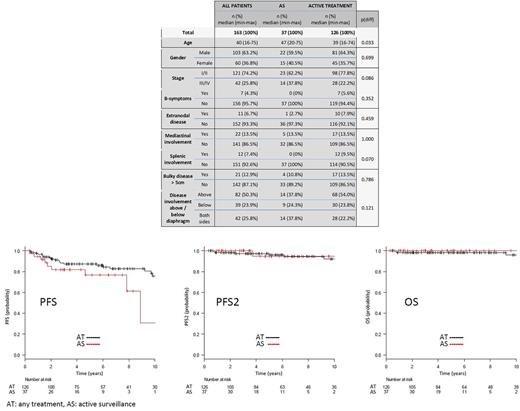Abstract

Background
Nodular lymphocyte-predominant Hodgkin lymphoma (NLPHL) is a rare disease. In the absence of consensus guidelines, treatment is controversial. Here, we describe the characteristics and outcomes of consecutive NLPHL patients diagnosed at Memorial Sloan Kettering Cancer Center (MSKCC) with a focus on active surveillance (AS) as a first-line management strategy.
Methods
We included consecutive patients aged 16 years (y) or older who were diagnosed and followed at MSKCC between 1974 and 2016. All cases were confirmed by a MSKCC hematopathologist as NLPHL without evidence of transformation. We excluded composite lymphomas and patients with any prior hematological malignancy or concomitant active cancer. We compared outcomes between patients followed expectantly (AS) and those treated actively (AT), which included radiotherapy (RT) only, chemotherapy (+/- Rituximab) (CT), combined modality (+/- Rituximab) (CMT), and rituximab monotherapy (R). Progression-free survival (PFS) was defined as time from diagnosis to a biopsy-proven disease progression or relapse, initiation of further treatment or death. PFS2 was defined as time from diagnosis to second biopsy-proven disease progression or relapse, initiation of 3rd-line treatment or death. AS was considered a 1st-line treatment. We used univariable and multivariable survival analyses stratifying patients by disease stage.
Results
In total, 163 patients were included. The median follow-up was 5.7y (Min-Max: 0.3 - 42.7) with 24.5% (n=40) of patients followed for 10y or more. Patient characteristics for all, AS and AT patients are shown in Table 1. Patients were treated with RT only (n=75, 46.0%), AS (n=37, 22.7%), CT (n=26, 15.9%), CMT (n=19, 11.7%) or R alone (n=6, 3.7%).
Overall, outcome of patients was excellent, with 10-year PFS, PFS2 and overall survival (OS) estimates of 71.2% [95%-CI: 59.3-80.1], 92.5% [95%-CI: 83.7-96.6] and 96.6% [95%-CI: 87.6-99.1], respectively. Seven patients died, 3 deaths were likely treatment related and only one lymphoma related death occurred after progression. Twelve transformations to aggressive lymphomas occurred after a median of 7.0y (Min-Max: 0.4 - 15.6). The transformation rate was 0.99% per patient year. Twelve secondary cancers occurred after a median of 7.8y (Min-Max: 1.1 - 24.8).
Only bulky disease ≥ 5 cm (n=21, HR: 3.1 [95%-CI: 1.3-7.2], p=0.008) and extranodal disease (n=11, HR: 7.7 [95%-CI: 2.1-28.5], p=0.002] were risk factors for a shorter PFS in the final multivariate model after correcting for received treatment.
In pairwise comparison, PFS with CMT (p=0.038) and RT (p=0.032) was superior to AS, but CT was not (p>0.999). PFS2 and OS were not significantly different between groups.
Patients, who received AT (n=126) overall tended to have superior PFS than those in the AS group (n=37) (5-year PFS 97.2% [95%-CI: 79.2-92.2] vs. 76.5% [95%-CI: 55.7-88.5], p=0.068), though this benefit was mainly seen in early stage disease (Ann Arbor I/II) (5-year PFS 94.2% [95%-CI: 86.7-97.6] vs. 65.1% [95%-CI: 43.5-80.2], p<0.001). This did not translate into better PFS2 (p=0.568) or OS (p=0.303) (Figure 1) and was confirmed in a multivariate model controlling for potential confounders that influenced the initial treatment decision. Comparing results in the AS and AT group, death occurred in 0 vs. 7 (0.0% vs. 5.6%), transformation in 2 vs. 10 (5.4% vs. 7.9%) and secondary cancers in 2 vs. 10 (5.4% vs. 7.9%) patients. Only 24.3% (n=9) of the 37 AS patients required treatment after a median of 5.1y (Min-Max: 0.3 - 23.2). Treatments after initial AS were localized radiation (n=4), R-CHOP (n=4) and R monotherapy (n=1) given for local symptoms (n=3), transformation (n=2), progressing nodes (n=2), systemic symptoms (n=1), adrenal insufficiency due to adrenal mass (n=1) and change of management strategy in stable disease (n=1).
Conclusion
NLPHL has an excellent prognosis. Bulky and extranodal disease were identified as potential risk factors for progression. With the limitations of a retrospective analysis, it can be concluded that AS is a viable management strategy in NLHPL. The majority of AS patients require no treatment after multiple years of observation and those that do, can be adequately managed with established treatments. Additionally, no evidence was found for an increased rate of transformation or worse PFS2 or OS in AS patients. Treatment related deaths exceeded deaths from lymphoma.
Moskowitz: Celgene: Consultancy; Genentech BioOncology: Consultancy; Seattle Genetics: Consultancy, Other: Ad Board, Research Funding; Merck: Consultancy, Research Funding; Pharmacyclics: Research Funding. Zelenetz: Genentech/Roche, GSK, Gilead, Celgene, Janssen, Hospira, Amgen, Takeda Pharma, Novartis, Nanostring Technologies, Portola Pharmaceuticals, Adaptive Biotechnology: Consultancy; GSK, Janssen, Roche, Gilead, Bristol Myers: Research Funding; Boehringer Ingelheim: Other: DMC Membership. Kumar: Seattle Genetics: Research Funding; Celgene: Membership on an entity's Board of Directors or advisory committees. Moskowitz: Incyte: Research Funding; Bristol Myers-Squibb: Consultancy, Research Funding; Seattle Genetics: Honoraria, Research Funding; Takeda: Honoraria; ADC Therapeutics: Research Funding.
Author notes
Asterisk with author names denotes non-ASH members.

This icon denotes a clinically relevant abstract


This feature is available to Subscribers Only
Sign In or Create an Account Close Modal